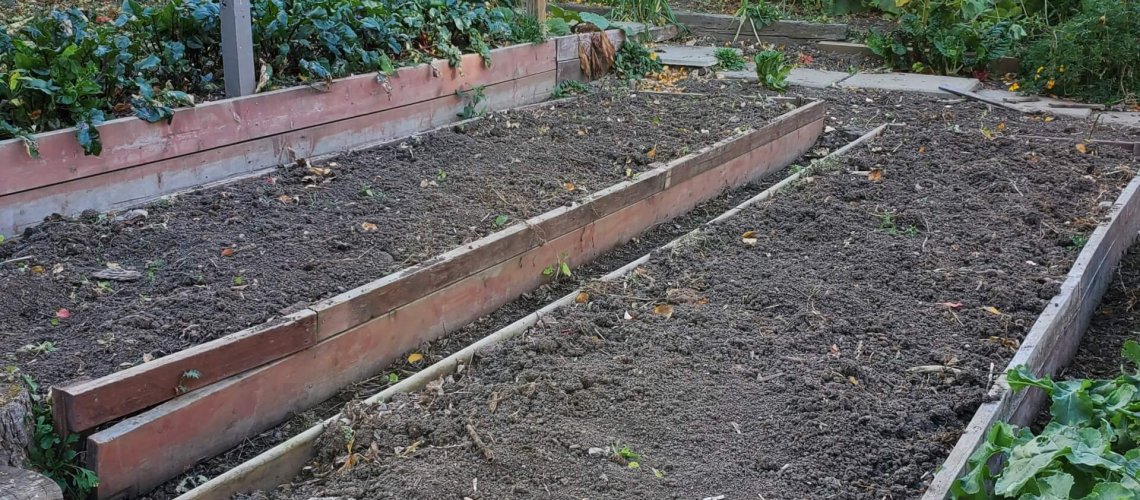While each plant thrives best on its unique needs, most urban gardeners are best off using a generic soil in which vegetables and flowers will grow satisfactorily, especially when you rotate crops. The best garden soil is an intimate mixture of clay, silt, sand, microorganisms, worms and other creatures, and of course compost. Add to this mixture, water and sunshine and you have ideal growing conditions.
To start, you must create a 16-inch depth of soil that has sufficient voids for water and air to allow the roots of your plants to grow and interact with the organisms in the soil. This starts with double digging. Double digging is necessary to create that sufficient depth. To double dig, first dig an 8-inch deep trench by throwing the dirt to one side. Choose a convenient width. Then dig another shovel depth and throw the dirt to the other side. Then as you dig the next trench, throw the top soil into the first trench. Add a generous layer of compost, leaves, or grass clippings and thoroughly mix them into the bottom layer. Add the bottom layer of the second trench on to the top of the first trench, also mixing it with compost, grass, leaves or other vegetable matter. Continue trench by trench until you have double dug the entire area you plan to garden.
An ideal soil has lots of pore space for air and water. You can improve the texture of heavy clay soil by adding sand. You can reduce the pH by adding spruce needles, or increase the pH by adding lime. However, all soils can always be improved by adding lots of compost. Year after year. The best compost is the compost you create yourself. If you are tempted to use compost from a local source, private or public, have it tested first. I have had the sad experience of using compost with a high salt content that killed my seedlings. If you are going to use manure, use horse or sheep manure. Cow manure has far, far, too many weed seeds.
There are a few simple tests to determine the quality of your soil. Take a handful of soil and squeeze it. If it is rough there may be too much sand and it will drain too fast. If it is slippery it has a lot of clay in it and it may not have enough pores to allow air to be present. Roots need air. Adding lots of compost will go a long way to creating good soil. If you want a professional analysis, send it to a test lab. They will tell you how to take a representative soil sample, then analyze it, and tell you how to improve your soil.
I prefer raised beds. See my article on raised, on how to build them and their advantages for gardening. Once you have prepared the soil, if you wish, you can install your raised beds and the walkways between them. The soil taken to create the walkway adds to the depth of soil in your bed.
For most of my raised beds, I use a no-till approach. No-till is simple; you do not dig. The reason for no-till is that there are many beneficial organisms in the soil that have a symbiotic relationship with your plants, helping both to thrive. Some microscopic fungi help certain plants take up phosphorous; others manufacture nitrogen. In return, plants provide a habitat on or along their roots. Some fungi attach to the plant roots and help the plant get water and nutrients, and in return the plant provides carbohydrates to the fungi. As the fungi roots die, they are eaten by bacteria, protozoa and other critters. The fungi also help to create a more porous soil or crumb. Earthworms create tunnels; their excretions also enrich the soil. Cultivation breaks up the web of life that enables healthy plant growth. So, break up the soil as little as possible. No till is the answer. (The above comes from an article in the 2012 Fall Issue of Mother Earth. I find other articles in the Mother Earth magazines interesting and very helpful.)
With raised beds, you need to only dig once every few years. The rest of the time do no-till gardening. When you want to loosen up the soil, use a broad ford to loosen up the soil. In my case, I only do it for the brassica beds as these plants do not use the microorganisms in the soil.
In addition to the compost created in my compost bins, I also create mulch/compost by adding layers of leaves and grass clippings to each walkway between the raised beds. In the fall I add leaves and grass clippings it to the walkways between the raised beds. In the spring I add the compost/mulch from the walkways to the raised beds and incorporate it into the soil. Then another layer is immediately added to the walkways. By the end of June, it is ready to act as a mulch for the growing plants. Then another layer is added to the walkways and placed on the raised beds in the fall. And yet another layer is added for the next spring. And so on, year after year. The continued layering in the walkways also helps to prevent weeds from growing in the walkways. I get the leaves from my neighbours in the fall and store them.
Once you have created your ideal soil, you must add a couple of inches of compost each year to maintain the tilth and provide food for the microorganisms. Add it to the top and rake it into the top few inches of your bed. The earthworms and various organisms will take it down further.
You will find that the time spent in preparing your soil will not only increase your production, but will save you time every year thereafter.

Recent Comments